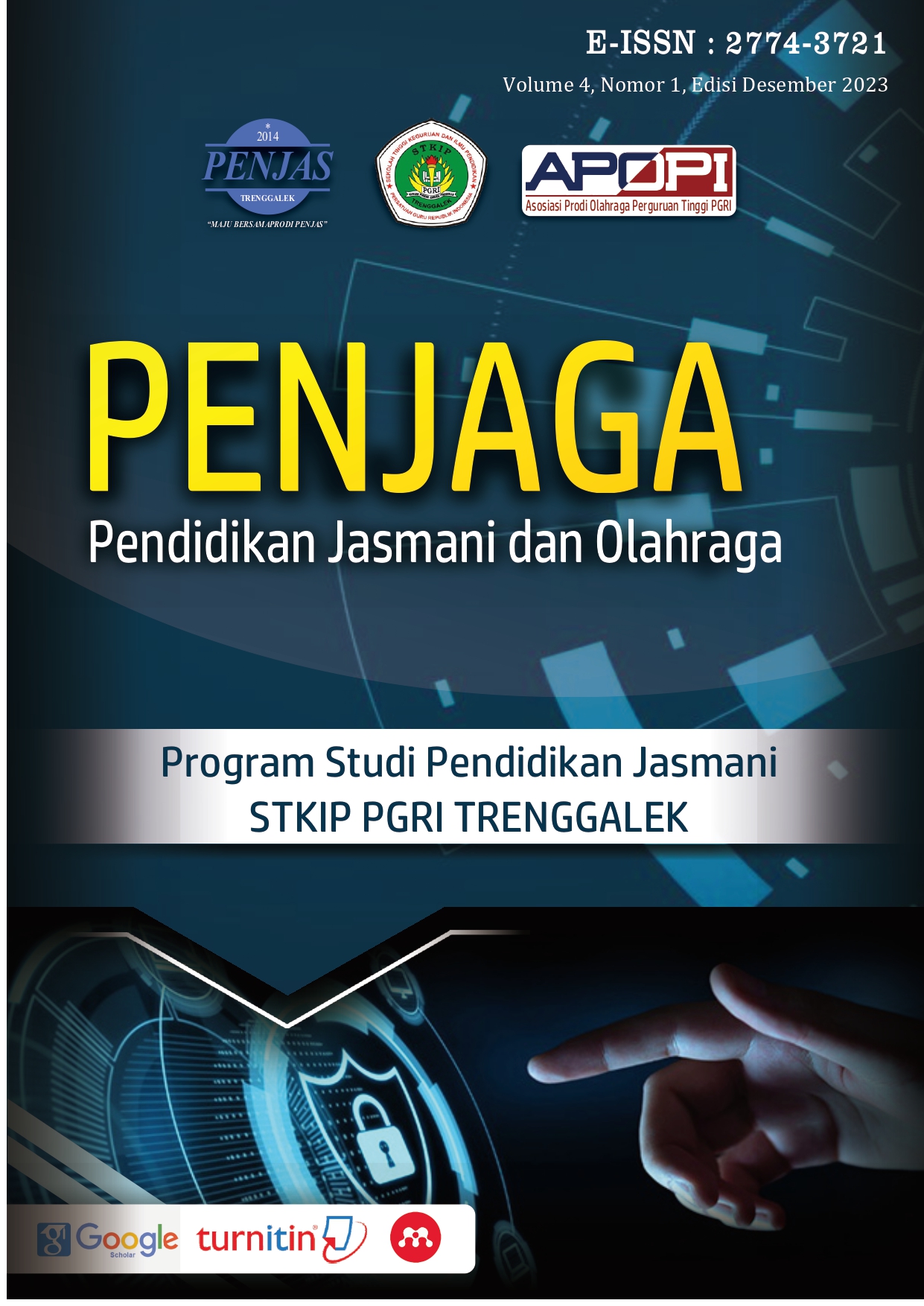Sedentary Lifestyle
Analysis Faktor Tingkat Kebugaran Jasmani Pada Perempuan Overweight
DOI:
https://doi.org/10.55933/pjga.v4i1.654Keywords:
Factor Analisys (FA), Kegemukan, Sedentary lifestyleAbstract
Kesehatan jasmani merupakan elemen kunci dalam memastikan kualitas hidup yang optimal. Perhatian terhadap tingkat kebugaran jasmani menjadi semakin penting, terutama ketika melibatkan perempuan yang mengalami overweight dan menjalani gaya hidup sedentary. Kondisi ini dapat memberikan kontribusi signifikan terhadap risiko berbagai penyakit kronis dan masalah kesehatan.Sedentary lifestyle dapat memicu peningkatan penumpukan akumulasi lemak tubuh, yang dapat meningkatkan resiko dislipidemia. Metode penelitian ini menggunakan eksperimen semu dengan jumlah 10 sample, untuk menganalisis tingkat kebugaran jasmani pada perempuan overweight dengan menggunakan factor analisis (FA). Hasil penelitian menunjukkan 3 Faktor utama yang dipengaruhi (PA1) Antroprometri Tubuh: FAT Mass, Viseral fat ratio, BB, FAT, Weist ruller, IMT, Met Age, Usia, (PA2) Penyakit: Kolesterol, Glukosa, (PA3) Komponen Biomotorik: kekuatan Leg Back, Push Pull, Fleksibilitas menurun. Dari data analysis ini menunjukkan bahwa pentingnya mengakui dan mengatasi sedentary lifestyle dalam populasi perempuan overweight. Langkah-langkah intervensi kesehatan yang melibatkan peningkatan aktivitas fisik dan perubahan gaya hidup menjadi relevan dalam upaya mencegah risiko overweight, menjaga kesehatan, dan meningkatkan kesejahteraan perempuan dalam kondisi ini
Downloads
References
Bastien, M., Poirier, P., Lemieux, I., & Després, J. (2014). ScienceDirect Overview of Epidemiology and Contribution of Obesity to Cardiovascular Disease. Progress in Cardiovascular Diseases, 56(4), 369–381. https://doi.org/10.1016/j.pcad.2013.10.016
Ciccarelli, M., Santulli, G., Pascale, V., Trimarco, B., & Iaccarino, G. (2013). Adrenergic Receptors And Metabolism : Role In Development Of Cardiovascular Disease. Frontiers in Physiology, 4(265), 1–6. https://doi.org/10.3389/fphys.2013.00265
Gillen, J. B., Martin, B. J., MacInnis, M. J., Skelly, L. E., Tarnopolsky, M. A., & Gibala, M. J. (2016). Twelve Weeks Of Sprint Interval Training Improves Indices Of Cardiometabolic Health Similar To Traditional Endurance Training Despite A Five-Fold Lower Exercise Volume And Time Commitment. PLoS ONE, 11(4), 1–14. https://doi.org/10.1371/journal.pone.0154075
Hall, J. E., Carmo, J. M., Silva, A. A., Wang, Z., & E, H. M. (2016). Obesity-Induced Hypertension: Interaction Of Neurohumoral And Renal Mechanisms. Circ Res, 116(6), 991–1006. https://doi.org/10.1161/Circresaha.116.305697.Obesity-Induced
Han, T. S., & Lean, M. E. J. (2016). A clinical perspective of obesity, metabolic syndrome and cardiovascular disease. JRSM Cardiovascular Disease. https://doi.org/10.1177/2048004016633371
Hruby, A., & Hu, F. B. (2015). The Epidemiology of Obesity: A Big Picture. In PharmacoEconomics. https://doi.org/10.1007/s40273-014-0243-x
Ma, E. B., Sahar, N. E., Jeong, M., & Huh, J. Y. (2019). Irisin Exerts Inhibitory Effect on Adipogenesis Through Regulation of Wnt Signaling. Frontiers in Physiology. https://doi.org/10.3389/fphys.2019.01085
Mamikutty, N., Thent, Z. C., Sapri, S. R., Sahruddin, N. N., Mohd Yusof, M. R., & Haji Suhaimi, F. (2014). The Establishment Of Metabolic Syndrome Model By Induction Of Fructose Drinking Water In Male Wistar Rats. BioMed Research International. https://doi.org/10.1155/2014/263897
Moreno-Fernández, S., Garcés-Rimón, M., Vera, G., Astier, J., Landrier, J. F., & Miguel, M. (2018). High Fat/High Glucose Diet Induces Metabolic Syndrome In An Experimental Rat Model. Nutrients. https://doi.org/10.3390/nu10101502
Nuzzo, J. L. (2019). The Case for Retiring Flexibility as a Major Component of Physical Fitness. Sports Medicine. https://doi.org/10.1007/s40279-019-01248-w
Pescatello, L. S. (2014). ACSM’S Guidelines for Exercise Testing and Prescription (E. Lupash (ed.); 9th ed.). Lippincott Williams & Wilkins.
Rask Larsen, J., Dima, L., Correll, C. U., & Manu, P. (2018). The Pharmacological Management Of Metabolic Syndrome. In Expert Review of Clinical Pharmacology. https://doi.org/10.1080/17512433.2018.1429910
Riskesdas. (2018). Hasil Utama Riskesdas Di Indonesia 2018. Hasil Utama Riskesdas Di Indonesia 2018, 8. https://doi.org/1 Desember 2013
Syamsudin, F. (2021). HIIT for Improving Maximal Aerobic Capacity in Adults Sedentary Lifestyle. Halaman Olahraga Nusantara (Jurnal Ilmu Keolahragaan), 4(1), 1. https://doi.org/10.31851/hon.v4i1.5139
Vigriawan, G. E., Putri, E. A. C., Rejeki, P. S., Qurnianingsih, E., Kinanti, R. G., Mohamed, M. N. A., & Herawati, L. (2022). High-Intensity Interval Training Improves Physical Performance Without C-Reactive Protein (CRP) Level Alteration In Overweight Sedentary Women. Journal of Physical Education and Sport, 22(2), 442–447. https://doi.org/10.7752/jpes.2022.02055
World Health Organization. (2016). Global Health Observatory (GHO) data Overweight and obesity. WHO.
Wolfman, L. S. B. A. (2013). Kebugaran Jasmani. Journal of Chemical Information and Modeling.

Downloads
Published
How to Cite
Issue
Section
License
Copyright (c) 2023 dio alif airlangga daulay, Gosy Endra Vigriawan, Fakhrur Rozy

This work is licensed under a Creative Commons Attribution-ShareAlike 4.0 International License.





